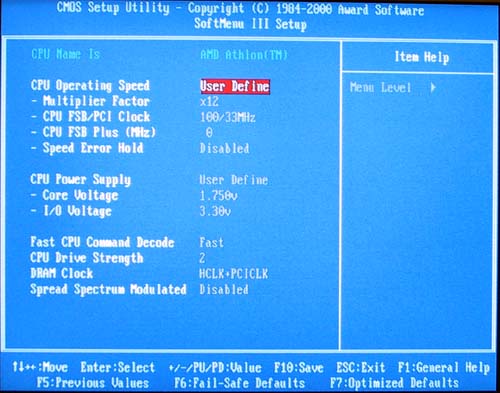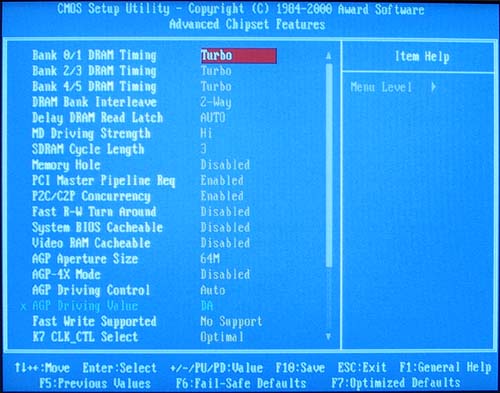ABIT KT7-RAID Socket-A KT133 ATX
by Anand Lal Shimpi on August 12, 2000 1:01 AM EST- Posted in
- Motherboards
ABIT's SoftMenu jumperless setup was what put the small Taiwanese company on the map when the feature made its initial debut. If you remember, back when ABIT introduced SoftMenu setting jumpers on the Socket-5/7 motherboards that dominated the industry was more than capping a few pins, there were tons of settings and one wrong setting would cause your system to fail the power on self-test or exhibit instability later on. These intimidating jumpers made ABIT's SoftMenu a blessing to the less experienced and a nice little convenience to those that had more experience with setting up motherboards. Their SoftMenu III setup is present on the KT7 and it makes the KT7-RAID the first board that supports the adjustment of the clock multiplier of Socket-A CPUs from within the BIOS.


As we've already discovered, as long as the "Golden Bridges" present at L1 on your Athlon/Duron CPU are connected, you can use the SoftMenu III's multiplier adjustment to change the clock multiplier of your CPU. If these "Golden Bridges" are not connected, then you simply have to connect them with some sort of conductive pen or conductive epoxy and then you're SoftMenu III regains its usefulness. This is the same for all Socket-A motherboards because of how AMD "locks" their Socket-A CPUs, a bit of effort but the end result is very promising when you have a Duron 600 running at 900MHz for little more than the cost of a conductive pen and 10 minutes of your time.

The KT7-RAID continues ABIT's unofficial support for an insane amount of FSB settings, in particular 100MHz up to 183MHz in 1MHz increments (the Athlon's EV6 bus operates, by default, at 100MHz DDR yielding an effective 200MHz FSB). Current motherboard designs do limit the effectiveness of FSB overclocking on KT133 motherboards so most of these settings will go unused, however the sheer number of settings guarantee that you'll find something that works reliably while making sure that you're getting the absolute most overclocking potential out of your system. For most users, the clock multiplier adjustment is the most important form of overclocking supported by the board but there are those that want to get every ounce of power from their setup, to them, the KT7 replies with a confident "go for it."
As any good motherboard should, the KT7-RAID supports manual adjustment of the core voltage supplied to your Socket-A CPU. The voltages supported range from 1.30v up to 2.05v in 0.05v increments which definitely do help when overclocking the Duron.
To help ensure that things stay nice and stable during all this overclocking, ABIT has included twelve 2200uF capacitors around the Socket-A interface to provide sufficient power to the CPU under all conditions. The KT7-RAID ran rock solid during our stability tests, coming in on par with ASUS' A7V, which is an incredible accomplishment from the company we were frowning upon because of their instability not too long ago. With the KA7, BX133-RAID, and now the KT7-RAID we're definitely seeing a positive move by ABIT to focus more on stability, a trend we certainly encourage.ABIT's user's manual wasn't packaged with our evaluation sample, it was only available on CD, however the manual is still up to ABIT's usual quality. The ABIT manual includes a fairly easy to read and useful explanation of the BIOS, CPU setup, RAID configuration, and makes the overall experience with the KT7-RAID, especially for first time system builders, a pleasant one.










0 Comments
View All Comments